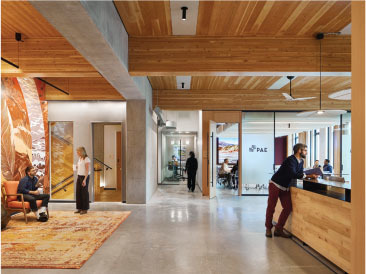March/April 2018
Communities: Private Practice
The Future Is Now
 Infrastructure investment and technological advancements generated economic growth during the last century. And this century will be no different, as resilient and sustainable infrastructure will be critical to prosperity and social progress, according to a recent AECOM report. The research provides insights from AEC industry professionals on the future of civil infrastructure and how the industry must deal with challenges from congested roads, power outages, flooding, drought, and cyberattacks.
Infrastructure investment and technological advancements generated economic growth during the last century. And this century will be no different, as resilient and sustainable infrastructure will be critical to prosperity and social progress, according to a recent AECOM report. The research provides insights from AEC industry professionals on the future of civil infrastructure and how the industry must deal with challenges from congested roads, power outages, flooding, drought, and cyberattacks.
Eighty percent of professionals surveyed believe that the industry must play a critical economic and societal leadership role in supporting technological programs and shaping the communities of the future. However, 67% feel that the industry is not evolving fast enough to meet society’s changing needs and deal with project-delivery challenges. Two out of every five major projects run into difficulties, which causes serious delays. Only 40% believe they are good at responding to changes, streamlining activities, and adopting innovative delivery models.
What are the barriers to the industry’s ability to deliver major civil infrastructure projects within the next five years? Respondents say the primary hurdles are lack of public funding (39%), political change and upheaval (27%), growing economic uncertainty (27%), skill and talent shortages (25%), pressure from environmental groups (22%), lack of private investment (22%), climate change and regularity of extreme-weather events (21%), and growing regulatory restrictions (20%).
More than 70% of industry professionals say that tried-and-tested approaches are out of sync with the complexities they face. They need new technologies: Three-quarters say alternative technical concepts from private contractors provide a great opportunity for innovation solutions.
The report outlines some remedies to the problems associated with innovative project delivery: realistic and fair project-risk sharing (36%); dedicated infrastructure funding (within national budget); local support from community businesses, taxpayers, and environmental groups (35%); stronger enabling legislation to help accelerate project delivery (27%); environmental and other enabling works started early or already in progress (27%); cleaner evaluation and selection criteria (27%); more focused political support (25%); and a fresh approach to contract drafting (25%).
The Engineer of 2030
Improved project delivery will also mean that AEC firms will need the right talent to move forward.
Over the next 10 years, the industry will continue to see new technologies disrupt the infrastructure sector in ways we can’t even imagine now, according to the AECOM study. This disruption will create new types of industries and jobs and make others obsolete.
1. New Rules, New Routes
It won’t just be an engineering degree that gets you through the door. The future infrastructure industry is going to be hungry for people qualified in information technology, communications, art and design, and life sciences.
2. Across Companies, Sectors, and Borders
As infrastructure programs grow in complexity and geographical scope, the ability to collaborate and work effectively in multidisciplinary teams across different organizations will be invaluable.
3. Innovating Across the Project Life Cycle
The future engineer will make regular use of present-day innovations such as BIM, artificial intelligence, and 3D printing. Engineers will be expected to identify and take advantage of the efficiencies that these and other innovative tools, such as sensors and robots, deliver.
4. And What Do You Do Here?
It’s increasingly likely that the jobs of future engineers will fall into three categories:
- Generalists—technical experts, also equipped to provide in-depth knowledge of clients’ key infrastructure challenges, from finance to regulation and program management;
- Data Specialists—coders, programmers, and analysts hired to harness the benefits of the latest technologies and mine the growing volumes of smart data for insights;
- Client Advisors—strong communicators focused on providing the best in customer service, and working as the face of their organizations.
5. Agile and Culturally Aware
With projects now crossing continents, and global trends such as urbanization and aging demographics driving the speed of change even further, future engineers must be able to respond rapidly to the latest industry developments and tailor their ways of working to the diverse needs of international clients.
Access The Future of Infrastructure.


 Volunteering at NSPE is a great opportunity to grow your professional network and connect with other leaders in the field.
Volunteering at NSPE is a great opportunity to grow your professional network and connect with other leaders in the field. The National Society of Professional Engineers (NSPE) encourages you to explore the resources to cast your vote on election day:
The National Society of Professional Engineers (NSPE) encourages you to explore the resources to cast your vote on election day:






